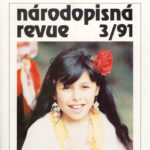The journal is devoted to Czechoslovak ethnography, especially to "folklorism" which represents a sort of the "second being" of the traditional forms of folk culture; in other words, the journal specializes in the popularization of folk culture. This very concept has had an irreplaceable position among other Czechoslovak journals dealing with the problems of ethnography; it represents the scholarly orientation of the publishing institute.
The link between science and its popularization can also be seen in the structure of the journal which contains original scholarly studies, re ports of folk celebrations and festivals, reviews of scholarly literature. The intention to popularize the results of the scholarly research is expressed in different genres: feuilletons, polemics and critiques dealing with the contemporary applied forms of traditional folk culture.
Jan Neruda: A Few Words about the Folk Song
The original feuilleton is devoted to the centenary of the death of the outstanding Czech poet and critic who also marginally dealt with ethnography. The feuilleton contains his reflections on the folk song which • as it seems after so many years - have a general validity.
Dušan Holý-Bartoloměj Daniel-Miloš Štědroň: Three Romany (gipsy) songs
(Auivlcate - Dade zlngaricum - Tikha vgordonaczka)
The first part of the study contains the analysis of the tune of the song linked with the text Aušvicate hi kher baro (In Auschwitz there stands a large prison) which has been carried out by the third member of the research team - the musicologist and composer He identifies in it the similar technique of composition as in the song Dade zingaricum which - together with the song Tikha vgordonaczka - was recorded as early as 1639. They are the records from Kajoni's codex which were first reprinted in 1909. The attempt to decipher the text of the song Tikha vgordonaczka was made by AndrasHajdu in 1955. He arrived at the conclusion which he did not regard as definitely valid and undisprovable. The second member of the research team - the native and educated Romany (gipsy) - came after a couple of collective discussions with D. H. to another possible solution the result of which in the translation into Romany (gipsy language) can be found in the second part of the article; the English translation including the title is the following: "The little woman-beggar. I am going to Lab begging bread for you, poor fellow." As for the translation of the song Dade zingaricum, it is the following: "The gipsy dad. And you, younger, tell me, why do you stay, do you stay in Senica? Give everything to Father,
Father. I will give horses, money to Father." The last part of the study is devoted to the analysis of the 17th-century melodies.
STRÁŽNICE 91 - the collection of the articles evaluating this year's 46th international folklore festival in Strážnice which represents the greatest show of folklore and folklorism in Czechoslovakia. The studies highly appraise the quality of the festival but also reveal some shortcomings consisting mostly in the old-fashioned conception and presentation of the folklore forms distant from the contemporary culture. On the other hand the need of presentation of the adequate and dignified forms of the original, authentic folklore is demonstrated. The following part of the journal is devoted to other Czechoslovak folklore ceremonies and festivals. Their contemporary organization is often connected with big financial problems and their content sometimes reflects commercial concepts. In spite of all that it can be stated that the presentation of folklore subjects still prevails in them. The critical assessment of ceremonies and festivals has been arranged according to the time of their realization in separate regions.
Helena Bočková: Festivals - When, Where and Why
The article deals with the importance of traditional festivals in the life of the society which have had a different form. They can substantionally be divided into secular and ecclesiastic - the latter had not been dealt with at all in previous years. The violent extinction of these festivals after 1948 led to the impoverishment of social life and to the change of the nature of festivals which obtained political and ideological character. Nowadays the original festivals are being reestablished and the elements of traditional culture (e. g. national costumes) the study of which is, however, part of folklorism, began to play an important role again in this process.
The following section contains reviews of both scholarly and popularizing literature.
The Selection of Reviewed Books:
Kolektiv: Západočeská vlastivěda, oddíl Národopis (Luboš Kafka).
Collective of authors: The West Bohemian Local History, section Ethnography (Luboš Kafka).
Jan Władysłąw Raczka: Architektura drewniana (iš). The Wooden Architekture.
Sborník příspěvků z ll. setkání historiků textilního a oděvního průmyslu (Jaroslav Šůla). The Miscellany of the Papers from the 2nd Meeting of the Historians of Textile and Clothing Industries.
Alois Haräsko: Bilder aus dem Sudetenland (Miroslava Ludvíková). Pictures from the Sudeten.
Luděk Štěpán, Josef Vařeka: Klíč od domova. Lidové stavby východních Čech (Václav Hrníčko). The Key to Home. Folk Houses in Eastern Bohemia.
This volume of the journal The Ethnographical Review is enriched by a few shorter articles, reports, quotations etc. As a whole it attracts readers attention by its new content and creative graphic design.



